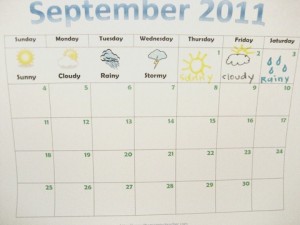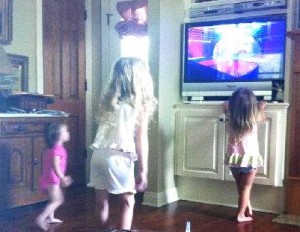I realized that I can still be a Mommy Teacher even though James is in big boy school now! I must have known this earlier because I bought him a few school supplies for his 4th birthday in July (even though his school only requires him to have 1 folder and a blanket for nap time). As soon as he got home he went straight to his
cool school kiddie corner to grab his notebook and pencil case. He asked me to make him some homework (here is where I started beaming :-D).
 |
| 4 times each because he’s 4 years old. His rule. |
1st Day
Looking through his art that his teacher sent home from school on the first day, I noticed that she had written his name on top of each paper with a highlighter and someone had traced his name with a pencil. I say someone because it was way too neat to be my son. Maybe the teacher helped guide his hand when tracing, but it was just way too neat. So I decided the first thing on our homework agenda was to practice writing his name.
As you can see, I wrote his name in highlighter, and he traced it. To teach him to always write from top-bottom, left-right, I sometimes had to draw a dot where he was supposed to start, and a dot where he was supposed to stop and pick up his pencil. This is a great way to teach directionality and print awareness. As you can see, he needs a little help working on writing dark enough. Putting pressure on his hands to show him how hard he was supposed to press helped, but writing lightly is a hard habit to break.
Next it was time to do some math! James has been dying to use his new super cool Cars ruler and he finally got his opportunity. He already understands that “inches” is a form of measurement and he constantly “measures” things in inches: “Mom, my foot is 18 inches!” “Mom, my scooter is 20 inches.” “Mom, this blanket is one hundred and ninety hundred and one thousand inches.” So I decided to shake things up a bit and teach him the difference between inches and centimeters.
I drew several lines of different lengths and he had to measure them using the centimeters side of the ruler. Then I drew the number he gave me using the highlighter and he had to trace it. (Very important to measure the lines first and make them have a length that comes to an exact whole number.) And guess what? Even in math we still practiced
fine motor skill development (handwriting), directionality, and
print awareness (again) in addition to
measurement and
number recognition.
Oh, and for every answer he got right, he got a piece of candy. It was snack time, after all, and my kids found my secret stash of candy, so we all 3 dove in! (Please don’t judge, my kids rarely eat candy, but as soon as they found my favorite candy, well, I wanted it too). It really made it exciting for him when he got the answer right or traced a letter well.
2nd Day
James has NEVER been enthusiastic about writing, drawing, or coloring. So when he comes home from school EXCITED to do homework, I definitely don’t want to make it too boring for him. So since we practiced his name yesterday, today I had him just work on one letter. Naturally, I chose the letter Aa.
He traced the uppercase “A” four times, lowercase “a” four times, then came up with four words that start with an A. He came up with “alligator, apple, and & ant.”
For Math we learned about squares and rectangles. He was able to tell me the difference between the two but he couldn’t describe WHY they are different.
Me: “Now how many sides does a square have?”
James: “1, 2, 3, 4.”
Me: “And how many does a rectangle have?
James: “It has 4 too!”
Me: “So if they both have 4 sides, how are they different?”
James: “Hmmm that’s a good question, Mom.”
So we took out our favorite school tool, the ruler, again. He measured the sides of the square and the sides of the rectangle and was then able to tell me the length of the sides.
James: “This one is 2 and 2 and 2 and 2 inches and this one is 2 and 2 and 6 and 6 inches!”
Then it clicked… * “Oooooh the rectangle has two sides that are longer!” Now he has the language to describe why one shape differs from another which is a higher-order thinking skill: he isn’t just understanding that there is a difference between the shapes, he is analyzing WHY the two are different. Then he got to draw his own rectangle and his own square from memory.
We also incorporated what we learned about the letter “Aa” by searching, identifying, circling and tracing the letter in each of the words square and rectangle.
So, on DAY 2 we covered letter recognition, phonemic awareness, fine motor skill development (writing), print awareness, directionality, shapes, measurement, and language development.
3rd Day
Well, with school comes germs, so we are home sick. New emotions: frustrated that we didn’t even last a whole week without catching somebodies ickies, and very snuggly, if snuggly was an emotion.
 |
| Still wearing his sticker he got from school yesterday. |
However, as soon as my youngest went down for a nap, James pulled out his school supplies… this time his markers. I drew several over-sized crayons onto paper and wrote different color names on them. James then had to sound out each of the words: “/r/ /e/ /d/… RED!” and then he had to find the red marker to color the red crayon. “/y/ /e/ /l/ /l/ /o/ /w/ Yelulahwuh! YELLOW!” Yup, a little trickier since the sounds changed up at the end. “/o/ /r/ /a/ /n/ /g/ /e/… um… what does THAT say?” Haha that one can trip anyone up! Here’s where we had a mini-lesson: “James, the letters o and r together say /or/. Can you think of a color that starts with /or/?”
Was the goal of this lesson to get James to sound out each word? No. The reason is that most of these words break the standard sound rules that he knows. This was a step in being able to recognize these sight words, words that we know how to read because we have memorized the shape the words make, and not by sounding them out. He was also able to learn to use reading clues to help him guess the word. “What color starts with /g/ and ends in /n/?” By modeling these types of questions for kids, they will learn to do the same thing when reading, or when solving problems in general!
 So what’s next on our homework agenda? Well, when more school work comes home I may get a better idea on what they are learning day-to-day, but for now, we will continue to work on the rest of the alphabet (both letter names and sounds) number recognition, making patterns, rhyming, language development, fine motor skill development (writing, using scissors, playing with play dough), measurement, compare/contrast and more!
So what’s next on our homework agenda? Well, when more school work comes home I may get a better idea on what they are learning day-to-day, but for now, we will continue to work on the rest of the alphabet (both letter names and sounds) number recognition, making patterns, rhyming, language development, fine motor skill development (writing, using scissors, playing with play dough), measurement, compare/contrast and more!
And we’ll definitely work on drawing…
 |
| “We are in a rocket ship.” Apparently. |
For a look at Louisiana Grade Level Expectations (GLEs) for Pre-K:
From the Louisiana Department of Education
For more about my adventures raising 2 boys, please visit my personal blog
“My Kidspiration: A Tale of 2 Kiddies”
And for more about Kidspired Creations:









